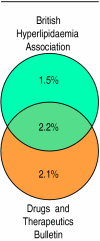Implications of applying widely accepted cholesterol screening and management guidelines to a British adult population: cross sectional study of cardiovascular disease and risk factors
- PMID: 9784450
- PMCID: PMC28695
- DOI: 10.1136/bmj.317.7166.1125
Implications of applying widely accepted cholesterol screening and management guidelines to a British adult population: cross sectional study of cardiovascular disease and risk factors
Abstract
Objective: To compare the implications of four widely used cholesterol screening and treatment guidelines by applying them to a population in the United Kingdom.
Design: Guidelines were applied to population based data from a cross sectional study of cardiovascular disease and risk factors.
Setting: Newcastle upon Tyne, United Kingdom.
Subjects: General population sample (predominantly of European origin) of 322 men and 319 women aged 25-64 years.
Main outcome measures: Proportions recommended for screening and treatment.
Methods: Criteria from the British Hyperlipidaemia Association, the British Drugs and Therapeutics Bulletin (which used the Sheffield table), the European Atherosclerosis Society, and the American national cholesterol education programme were applied to the population.
Results: Proportions recommended for treatment varied appreciably. Based on the British Drugs and Therapeutics Bulletin guidelines, treatment was recommended for 5.3% (95% confidence interval 2.9% to 7.7%) of men and 3.3% (1.5% to 5.3%) of women, while equivalent respective values were 4.6 (2.3 to 6.9) and 2.8 (1.0 to 4.6) for the British Hyperlipidaemia Association, 23% (18.4% to 27.6%) and 10.6% (7.3% to 14.0%) for the European Atherosclerosis Society, and 37.2% (31.9% to 42.5%) and 22.2% (17.6% to 26.8%) for the national cholesterol education programme. Only the British Hyperlipidaemia Association and Drugs and Therapeutics Bulletin guidelines recommend selective screening. Applying British Hyperlipidaemia Association guidelines, from 7.1% (4.3% to 9.9%) of men in level one to 56.7% (51.3% to 62.1%) of men in level three, and from 4.4% (2.1% to 6.7%) of women in level one to 54.4% (48.9% to 59.9%) of women in level three would have been recommended for cholesterol screening. Had the Drugs and Therapeutics Bulletin guidelines been applied, 22.2% (16.5% to 27.9%) of men and 12.2% (8. 6% to 15.8%) of women would have been screened.
Conclusions: Without evidence based guidelines, there are problems of variation. A consistent approach needs to be developed and agreed across the United Kingdom.
Figures
Comment in
-
Cholesterol screening and management guidelines. Having several guidelines is confusing.BMJ. 1999 Apr 24;318(7191):1140. doi: 10.1136/bmj.318.7191.1140a. BMJ. 1999. PMID: 10213742 Free PMC article. No abstract available.
-
Cholesterol screening and management guidelines. Policy based on Sheffield table fully satisfies authors' criteria.BMJ. 1999 Apr 24;318(7191):1140-1. BMJ. 1999. PMID: 10366266 No abstract available.
Similar articles
-
Application of the European Society of Cardiology, Adult Treatment Panel III and American College of Cardiology/American Heart Association guidelines for cardiovascular risk management in a French cohort of rheumatoid arthritis.Int J Cardiol. 2015 Mar 15;183:149-54. doi: 10.1016/j.ijcard.2015.01.069. Epub 2015 Jan 28. Int J Cardiol. 2015. PMID: 25666124
-
Comparison of application of the ACC/AHA guidelines, Adult Treatment Panel III guidelines, and European Society of Cardiology guidelines for cardiovascular disease prevention in a European cohort.JAMA. 2014 Apr 9;311(14):1416-23. doi: 10.1001/jama.2014.2632. JAMA. 2014. PMID: 24681960
-
Implications of American College of Cardiology/American Heart Association (ACC/AHA) Cholesterol Guidelines on Statin Underutilization for Prevention of Cardiovascular Disease in Diabetes Mellitus Among Several US Networks of Community Health Centers.J Am Heart Assoc. 2017 Jul 3;6(7):e005627. doi: 10.1161/JAHA.117.005627. J Am Heart Assoc. 2017. PMID: 28673901 Free PMC article.
-
Unmet need in the hyperlipidaemia population with high risk of cardiovascular disease: a targeted literature review of observational studies.BMC Cardiovasc Disord. 2016 Apr 26;16:74. doi: 10.1186/s12872-016-0241-3. BMC Cardiovasc Disord. 2016. PMID: 27114245 Free PMC article. Review.
-
Guidelines for Cervical Cancer Screening in Immunosuppressed Women Without HIV Infection.J Low Genit Tract Dis. 2019 Apr;23(2):87-101. doi: 10.1097/LGT.0000000000000468. J Low Genit Tract Dis. 2019. PMID: 30907775
Cited by
-
The effect of hypertension and hypercholesterolemia screening with subsequent intervention letter on the use of blood pressure and lipid lowering drugs.Br J Clin Pharmacol. 2004 Mar;57(3):328-36. doi: 10.1046/j.1365-2125.2003.02011.x. Br J Clin Pharmacol. 2004. PMID: 14998429 Free PMC article. Clinical Trial.
-
Management of hypertension. Ideal body weight is not realistic goal for lifestyle intervention.BMJ. 2000 Feb 26;320(7234):576; author reply 579-80. BMJ. 2000. PMID: 10688571 Free PMC article. No abstract available.
-
[The quality of the drug treatment in hyperlipemia patients from 4 health areas. The VICAF Group].Aten Primaria. 2000 Oct 15;26(6):368-73. doi: 10.1016/s0212-6567(00)78685-9. Aten Primaria. 2000. PMID: 11111308 Free PMC article. Spanish.
-
Estimating cardiovascular risk for primary prevention: outstanding questions for primary care.BMJ. 2000 Mar 11;320(7236):702-4. doi: 10.1136/bmj.320.7236.702. BMJ. 2000. PMID: 10710585 Free PMC article. No abstract available.
-
Methodological and reporting quality of pediatric clinical practice guidelines: a systematic review.Ann Transl Med. 2021 Aug;9(15):1258. doi: 10.21037/atm-21-2686. Ann Transl Med. 2021. PMID: 34532395 Free PMC article. Review.
References
-
- NHS Centre for Reviews and Dissemination. Implementing clinical practice guidelines. Effective Health Care 1994;4(1).
-
- Grimshaw J, Russell I. Effect of clinical guidelines on medical practice: A systematic review of rigorous evaluations. Lancet. 1993;342:1317–1322. - PubMed
-
- Ramsay L, Haq I, Jackson P, Yeo W. The Sheffield table for primary prevention of coronary heart disease: corrected. Lancet. 1996;348:1251–1252. - PubMed
-
- Standing Medical Advisory Committee. The use of statins. London: Standing Medical Advisory Committee; 1997.
Publication types
MeSH terms
Substances
LinkOut - more resources
Full Text Sources
Medical

